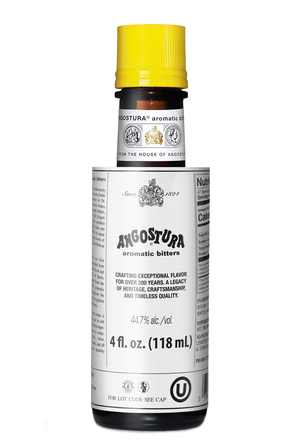Are you a Discerning Drinker?
Join thousands of like-minded professionals and cocktail enthusiasts, receive our weekly newsletters and see pages produced by our community for fellow Discerning Drinkers.
Words by Simon Difford

Johann Gottlieb Benjamin Siegert, a German doctor, created Angostura Bitters to treat stomach disorders and indigestion in a military hospital in the town of Angostura, Venezuela. Thanks to sailors they travelled the world and via the punch found their way into cocktails and have since become a mainstay in drinks such as the Rum Punch, Manhattan and Vieux Carre.
There are now numerous other brands of aromatic bitters, many containing Angostura Bark. However, it's worth remembering the original Angostura Bitters take their name from the town where they originated and despite this name, do not contain Angostura Bark.
In his 1872 Cooling Cups and Dainty Drinks William Terrington wrote, "The Americans have a few bitter liquors, of which Boker's and Angostura are decidedly the best. In England, the bitters of the public-houses are invariably made of spirit, from orange-peel, cassia, gentian, cardamom seeds, or any other bitter that fancy dictates. The well-known tonic or bitter-cup is made of quassia wood. It is reputed to be stomachic, and to assist digestion."
Angostura becomes an essential component in the cocktail books that follow with O-H-Byron stating in his 1884 The Modern Bartenders Guide, "We use none but Boker's, or the genuine Angostura bitters; the latter possesses a certain rich flavour and delicate perfume, altogether unapproachable by other."
A lot has changed in the 13 decade since Byron wrote his book and there are now a plethora of other aromatic bitters available to bartenders and home cocktail enthusiasts, may with specific flavour profiles directed to particular cocktails, but Angostura, and other similarly styled bitters, remain in broad use across over 450 cocktail recipes, particularly those based on rum, whisk(e)y and brandy.

Angostura Aromatic Bitters
Category: Spirits
Sub category: Bitters & tinctures etc.
alc./vol: 44.7

Suze Aromatic Bitters
Category: Spirits
Sub category: Bitters & tinctures etc.
alc./vol: 45

Australian Bitters Aromatic
Category: Spirits
Sub category: Bitters & tinctures etc.
alc./vol: 45

Seiers Aromatic Bitters
Category: Spirits
Sub category: Bitters & tinctures etc.
alc./vol: 39.5

Dashfire Old Fashioned Bitters
Category: Spirits
Sub category: Bitters & tinctures etc.
alc./vol: 40

Scrappy's Aromatic Bitters
Category: Spirits
Sub category: Bitters & tinctures etc.
alc./vol: 47

Bittermens Transatlantic Modern Aromatic Bitters
Category: Spirits
Sub category: Bitters & tinctures etc.
alc./vol: 45

Malidea Mirto Bitters
Category: Spirits
Sub category: Bitters & tinctures etc.
alc./vol: 47

Bittercube Bolivar Bitters
Category: Spirits
Sub category: Bitters & tinctures etc.
alc./vol: 44

Saint James Bitters
Category: Spirits
Sub category: Bitters & tinctures etc.
alc./vol: 44.5




